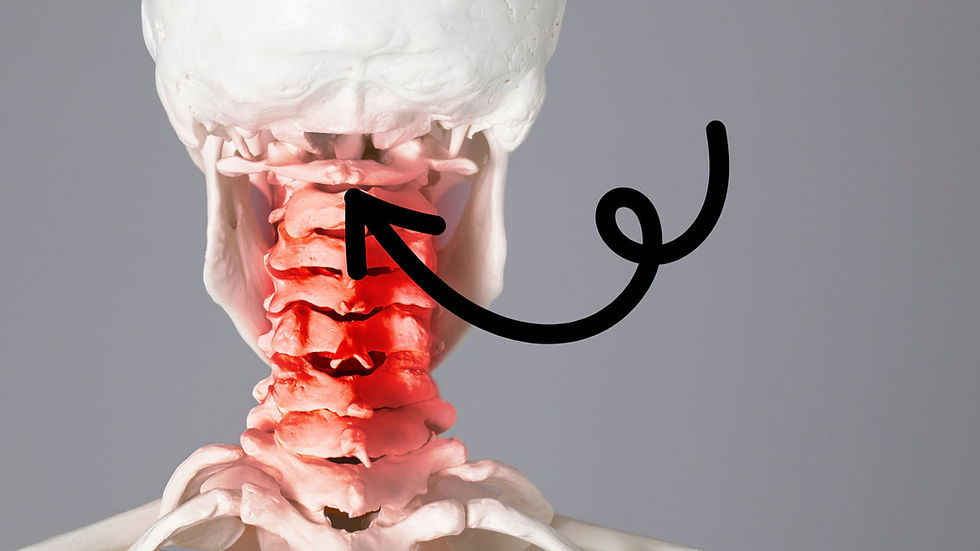The Atlas: A Small but Mighty Component of Spinal Health
- Pittsburgh Migraine Challenge Staff
- Feb 19
- 3 min read
Updated: Feb 20

The human spine is a complex structure that provides stability, protects the spinal cord, and enables a wide range of motion. At the very top of this intricate system is the atlas, the first cervical vertebra (C1), aptly named after the mythical Titan who carried the heavens on his shoulders.
The Critical Function of the Atlas
The atlas is responsible for supporting the skull and facilitating its movement, but its significance extends beyond just mechanics. When this vertebra is misaligned, it can contribute to various health problems, particularly chronic headaches and migraines.
Understanding Atlas Anatomy
Positioned just below the base of the skull, the atlas forms the atlanto-occipital joint, which connects it to the occipital bone. Unlike the rest of the vertebrae, the atlas is unique because it lacks a vertebral body and spinous process. This specialized structure allows it to:
Bear the weight of the skull – The atlas distributes the skull's weight evenly along the spine.
Enable movement – Working in tandem with the axis (C2), the atlas allows the head to rotate, tilt, and nod.
Safeguard the nervous system – The spinal cord passes through the atlas, making it a crucial conduit between the brain and body.
How an Atlas Misalignment Contributes to Headaches and Migraines
When the atlas is out of position, it can trigger a chain reaction of problems that may result in headaches or migraines. Below are some of the primary ways this occurs:
1. Nerve Compression
Because of its proximity to the brainstem, the atlas plays a vital role in nerve function. A misalignment can place pressure on nerves, including the vagus nerve and other cranial nerves, leading to pain signals that manifest as headaches or migraines.
2. Restricted Blood Flow
The vertebral arteries, which supply oxygen-rich blood to the brain, pass through openings in the cervical vertebrae. When the atlas is misaligned, it can disrupt this flow, potentially triggering migraines due to reduced oxygen and nutrient supply.
3. Increased Muscle Tension
A misaligned atlas can cause compensatory changes in posture, leading to chronic muscle tension in the neck and shoulders. This muscle strain often radiates upward, contributing to tension headaches or exacerbating migraine symptoms.
4. Disrupted Cerebrospinal Fluid (CSF) Circulation
The atlas influences the flow of cerebrospinal fluid, which cushions the brain and spinal cord. Any disruption in this flow can increase intracranial pressure, a known factor in migraines.
Recognizing Symptoms of Atlas Misalignment
Headaches and migraines are just some of the potential consequences of an atlas misalignment. Other symptoms may include:
Chronic neck pain or stiffness
Dizziness or vertigo
Jaw pain or temporomandibular joint (TMJ) dysfunction
Persistent fatigue
Numbness or tingling in the arms and hands
Diagnosing and Correcting Atlas Misalignments
If you suspect your atlas is misaligned, it is essential to seek guidance from a healthcare professional specializing in spinal health, such as a chiropractor, osteopath, or physical therapist. These specialists use diagnostic tools such as:
Physical examinations
X-rays or advanced imaging
Postural assessments
Treatment Options:
Chiropractic Adjustments: Gentle and precise realignments of the atlas can relieve nerve pressure and restore proper blood flow. Schedule an appointment with Dr. Cotey today.
Physical Therapy: Targeted exercises and stretches can correct muscle imbalances caused by misalignment.
Lifestyle Modifications: Improving posture, reducing stress, and using ergonomic techniques can help maintain spinal alignment and prevent future issues.
Preventative Strategies for Atlas Health
Taking proactive steps to protect spinal alignment can help minimize the risk of atlas-related issues. Consider the following tips:
Maintain proper posture, especially while sitting or working at a desk.
Use a supportive pillow to keep your neck in alignment while sleeping.
Take frequent breaks from screen use to reduce neck strain.
Engage in regular physical activity to strengthen the muscles supporting your spine.
Conclusion
Though small in size, the atlas vertebra plays a significant role in overall health. Misalignments in this crucial cervical vertebra can lead to chronic headaches, migraines, and other health concerns. By recognizing its impact and taking preventative measures, individuals can improve their spinal health and potentially find relief from persistent headaches. If you struggle with chronic migraines, assessing the health of your atlas may be the key to long-term relief.



